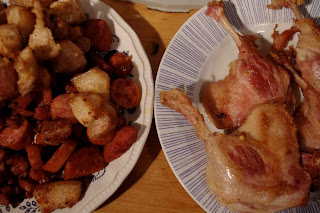These are semisoft with a tart lemon flavor—an old-fashioned cookie from Florida.
Maida Heatter’s Book of Great Cookies, pp 45–6
It had been a sorry while since any biscuits were baked. And to my horror and despair, when the time was finally found to bake biscuits, Maida Heatter’s Book of Great Cookies was nowhere to be seen. I could see the empty space between its chronologically-ordered sisters of Maida’s prolific late-70s period. I searched high and low. I checked that I hadn’t put it in the fridge. I blamed The Guitar Teacher, one of his students and the estate agent in that order, as the only souls to darken our door in the last fortnight.
‘It’s probably fallen down the back of the cabinet,’ TGT suggested, unhelpfully, as it was clearly impossible that such a hefty tome could fall down there.
‘What utter codswallop,’ I said dismissively, or words to that effect. ‘Anyway, it’s too hard to drag that great thing out to have a look.’
He nodded. ‘I’ll just grab the torch, shall I?’
Lo and behold, there it was, caught in the web of cords from the stereo, its little Post-it flags waving. You didn’t see that coming, did you, dear reader? A happy ending! Albeit one with some degree of egg on my face! I can’t help feeling that a happy ending makes this tale a tad flat and pointless, as it would Madame Bovary or Anna Karenina, and I have no idea how I got onto them, so without further ado, to Lemon Walnut Wafers.
1½ cups plain flour
½ teaspoon baking powder
¼ teaspoon kosher salt (Because I have bought some now, so often do recipes call for it. Does it differ from Saxa? Don’t ask me. But you could probably use whatever salt you like, really.)
Generous pinch ground ginger
120g unsalted butter, left out to soften if you manage to plan ahead. Me, I zapped it in the microwave for 10 seconds.
1 cup sugar
1 egg plus 2 egg yolks
1 lemon, zest and juice
60g walnuts, roughly chopped
Preheat oven to 180C.
Sift together flour, baking powder, salt and ginger and set aside.
Cream the butter by electric means (or hand – I don’t wish to exclude you, Alida Irwin), then add sugar and beat well. Add the egg and yolks, beating until the mixture is light and fluffy. On a low speed (you just stir normally, AI), gradually add sifted dry ingredients, mixing only until smooth. Mix in the lemon zest and juice and the walnuts by hand.
Blob rounded teaspoonfuls of the mixture onto baking-paper-lined trays, at least an inch apart (Maida recommends two inches, but I have a puny oven and meagre trays, and the biscuits didn’t spread far). It’s a sticky mixture and the blobs weren’t prettily rounded, but they sorted themselves out in the baking.
Bake for 20 minutes, or until the tops spring back when lightly pressed. Maida says, ‘These cookies will not brown on the tops, but there will be a thin brown edge.’ As always, she recommends reversing trays to ensure even browning, and, this time, I would have done well to follow this instruction – as it was, the front row had browned on their peaks while the rest were fish-belly pale.
Cool on racks. Do I even need to mention that?
As I suspected, these bore no more relation to wafers than this blog does to tragic nineteenth-century realism. They tasted pleasingly lemony, but were US-style soft and cakey; a bit more browning and crisping all over would have been an improvement rather than something to avoid. One to file away for the false-teeth years, which are not, after all, so far off. Or perhaps I should refer to those as the naked-gums years – with all signs pointing to my generation not being able to afford housing in retirement, dentistry probably won’t be on the cards either. We could end up living out a Russian novel after all.






















































